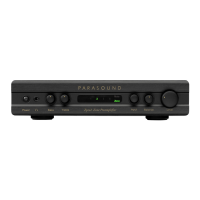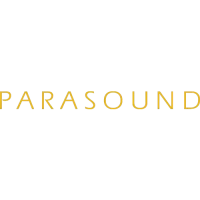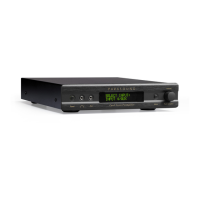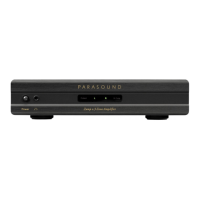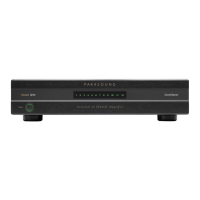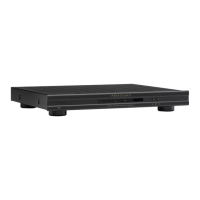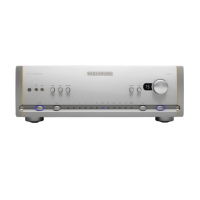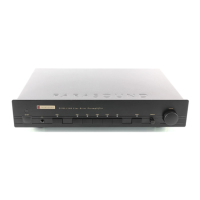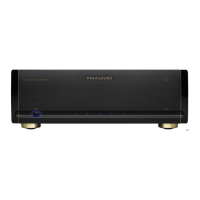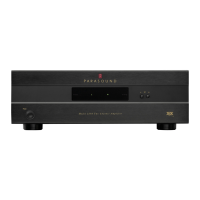Do you have a question about the Parasound Zphono-USB and is the answer not in the manual?
Safely unpack the Zphono-USB, inspect for damage, and retain packaging materials.
Position the unit away from heat sources, ensuring adequate ventilation for optimal performance.
Instructions for rack mounting the Zphono-USB in a 19" equipment rack using optional accessories.
Details on the 115V/230V switch, its location, and the importance of correct setting to prevent damage.
Connect turntables to Phono inputs and other sources to Line inputs; attach ground wire.
Select the correct cartridge setting (MC-100Ω, MC-47kΩ, MM-47kΩ) for optimal gain and load impedance.
Connect line-level sources like CD players or tuners to Line 1 and Line 2 inputs.
Connect to stereo via analog Line Out or to computer via digital USB Out.
Details on GND connector and AC Line Cord connection for proper setup.
Explain cartridge switch settings (MM-47kΩ, MC-100Ω, MC-47kΩ) for gain and load impedance.
Information on RIAA EQ switch for USB output and its effect on sound.
Explanation of AC Polarity switch for hum elimination and safety precautions.
Detailed functions of Power Button, Headphone Jack, Input Indicator, Mono Button, Rumble Filter.
Explains the USB Clip indicator and how to avoid distorted digital recordings.
Adjusts audio level for USB output; critical for recording quality.
Step-by-step guide to adjusting USB Gain for optimal digital recording quality.
Lists recommended software programs for computer recording.
Configure Windows 7 for stereo recording and achieve best quality.
Guidance on recording to a computer, including software requirements.
"USB Audio CODEC" is a generic Windows term for USB audio devices.
Seek help from the recording software manufacturer, not Parasound.
Solutions for quiet recordings or background hiss.
Solutions for loud, fuzzy, or distorted recordings.
Troubleshooting bass/treble issues via RIAA EQ and cartridge settings.
Explanation for mono recordings and ensuring stereo setup.
Guidance on interpreting brief flashes of the USB Clip indicator.
Reasons why the USB Clip indicator might not activate.
Common causes for no sound, including cable connections and input selection.
Solutions for background hum, covering ground wire, AC polarity, etc.
Troubleshooting distorted/loud sound related to incorrect cartridge settings.
Troubleshooting weak sound related to incorrect cartridge settings.
Information on contacting Parasound for technical support and warranty service.
Procedures for returning the unit for service, including RA numbers and documentation.
Technical specification for the audio frequency response range.
Technical specification for the total harmonic distortion level.
Technical specification for the signal-to-noise ratio for MM cartridges.
Technical specification for the signal-to-noise ratio for MC cartridges.
Technical specification for the signal-to-noise ratio for line inputs.
Technical specification for the output impedance.
Technical specification for the phono input impedance settings.
Technical specification for input sensitivity at 1 kHz for MM and MC.
Technical specification for the USB Analog-to-Digital converter.
Technical specification for required AC power input voltage and frequency.
Physical dimensions of the Zphono-USB unit.
Net and shipping weight of the Zphono-USB unit.
Information on optional rack mounting accessories.
| USB Output | Yes |
|---|---|
| Gain (MM) | 40 dB |
| Gain (MC) | 60 dB |
| Frequency Response | 20 Hz - 20 kHz |
| Power Supply | AC |
| Dimensions | 8.5 x 6.5 x 2 inches |
| Weight | 2.5 lbs |
| THD | < 0.01% |
| Input Impedance (MM) | 47k Ω |
| Input Capacitance | 100 pF |
| RIAA Accuracy | ±0.5 dB |
| USB Version | USB 2.0 |
| Outputs | RCA |
| Frequency Response Tolerance | ±0.5 dB |
| Input Impedance (MC) | 100 Ω |
| Input Type | MM/MC |
| Signal to Noise Ratio | 80 dB |
| Signal-to-Noise Ratio (MM) | 80 dB |
